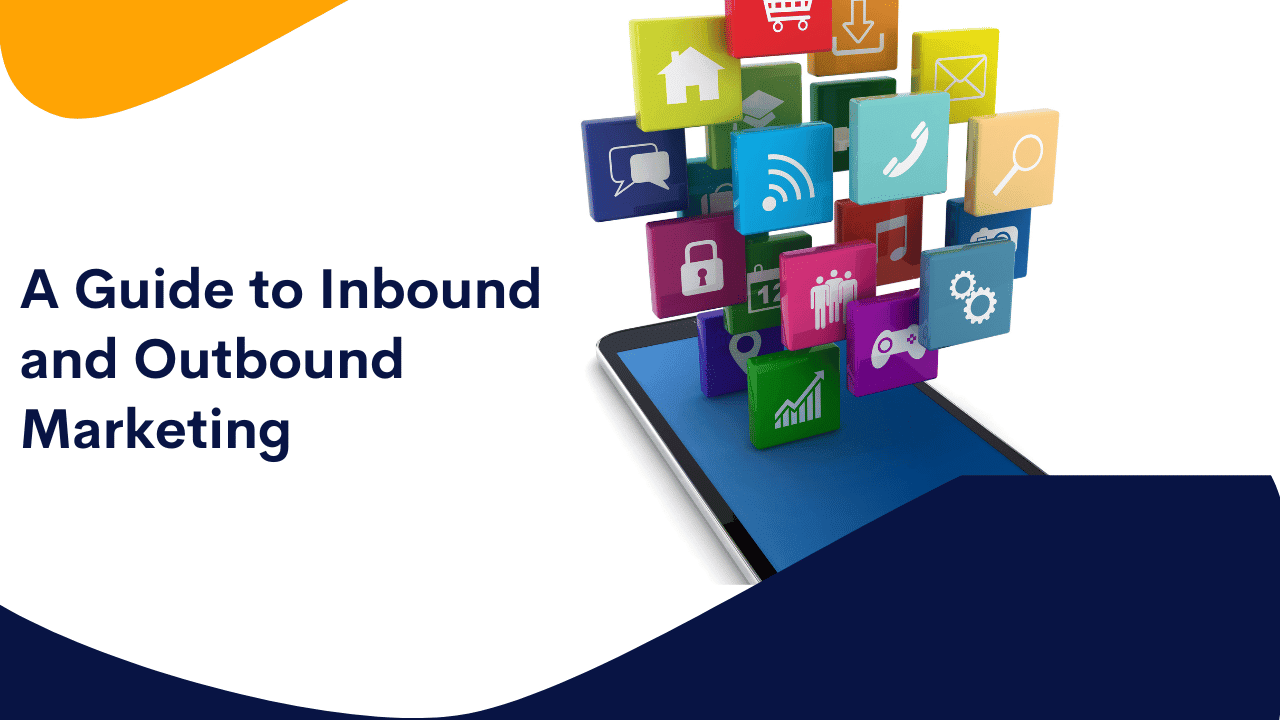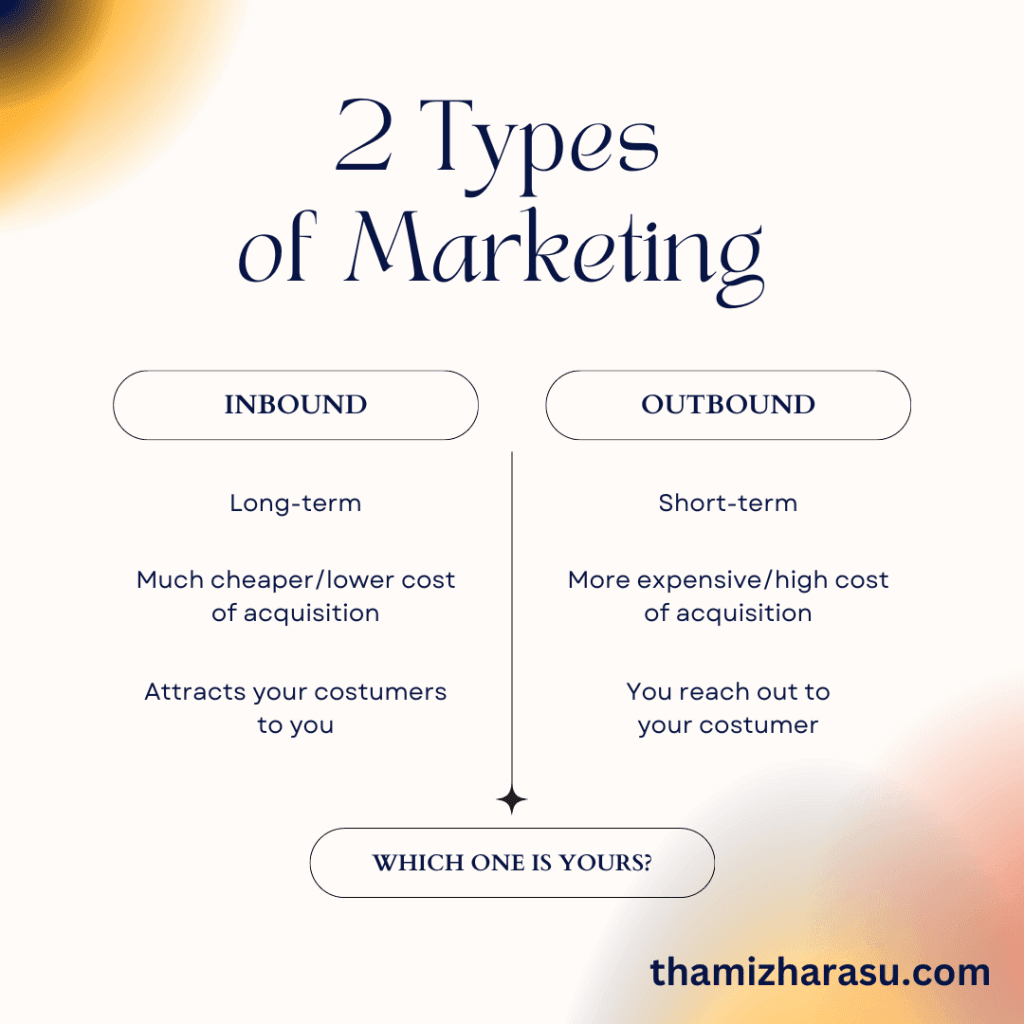- 10/03/2023
- Posted by: Thamizharasu Gopalsamy
- Category: Marketing

As a business owner, you know that marketing is crucial for your success. But with so many options out there, it can be overwhelming to choose the right approach. Two popular methods are inbound and outbound marketing, each with its own unique benefits and drawbacks. In this post, A Guide to Inbound and Outbound Marketing we’ll explore both strategies in detail and help you determine which one is best suited for your business needs. Get ready to discover a world of differences between these two approaches!
What is outbound Marketing?
Outbound marketing is a type of marketing that involves the proactive pursuit of potential customers. Marketers using an outbound approach typically rely on tactics like TV advertising, Newspaper advertising, Magazine advertising, cold-calling, and Trade shows to reach their target audience.
While outbound marketing can be effective, it can also be quite disruptive and intrusive. Some businesses like FMCG and mass-market products along with considerable budgets can rely on outbound marketing.
What is inbound Marketing?
Inbound marketing is a type of marketing that focuses on creating and sharing content that attracts attention and drives traffic to your website. Unlike outbound marketing, which involves interrupting people with ads or cold calls, inbound marketing provides potential customers with the information they’re already interested in.
Some common examples of inbound marketing content include blog articles, ebooks, infographics, and webinars. By creating helpful, informative content, you can build trust and credibility with your target audience, and eventually turn them into paying customers.
What is Inbound vs. Outbound Marketing?
Inbound marketing and outbound marketing are two completely different approaches to marketing. Inbound marketing is all about attracting customers to your business through compelling content and offers, while outbound marketing is about interrupting potential customers with your message in the hopes of getting their attention.
So, which one is best for your business? The answer may surprise you.
While outbound marketing can be effective in certain situations, it’s generally not as effective as inbound marketing. Outbound marketing is often seen as intrusive and annoying, and it can be very expensive.
In contrast, inbound marketing is much more effective at generating leads and converting them into customers. Additionally, it’s significantly less expensive than outbound marketing.
If you’re looking to generate more leads and convert them into customers, inbound marketing is the way to go.

Pros and Cons of Inbound Marketing
Inbound marketing is a great way to attract customers organically and build relationships with them. However, it can be costly and time-consuming, and there is no guarantee that your efforts will pay off.
Outbound marketing is more traditional and can be expensive, but it can also be less effective if you are not targeting the right customers and the right medium.
So, which is best for your business? It depends on your goals, budget, and target audience. If you’re not sure where to start, try experimenting with both types of marketing to see what works best for you.
Pros and Cons of Outbound Marketing
Outbound marketing is the traditional form of marketing that involves proactively reaching out to customers through direct channels like TV, radio, print, and telemarketing. In recent years, with the rise of digital channels like the internet and social media, outbound marketing has become less effective as consumers have become more resistant to advertising messages that interrupt their everyday lives.
There are still some advantages to outbound marketing, however. Because it is a more direct form of marketing, it can be easier to measure the results of your campaigns and adjust them accordingly. Outbound marketing can also be useful for building brand awareness in new markets or among new customer segments.
The main disadvantage of outbound marketing is that it is much more expensive than inbound marketing, and it is also less likely to generate leads that convert into customers. In addition, outbound marketing can damage your brand if not executed carefully.
Examples of Successful Inbound and Outbound Campaigns
There are many different types of inbound and outbound marketing campaigns that can be successful, depending on the products or services being marketed and the target audience.
Some examples of successful inbound marketing campaigns include creating informative blog content, developing helpful how-to videos, offering free e-books or white papers, and holding webinars. These types of campaigns attract potential customers who are already interested in what you have to offer and are more likely to convert into paying customers.
Outbound marketing campaigns can also be successful if they are well-targeted and timed correctly. For example, direct mail campaigns that coincide with a new product launch or sale can generate a lot of interest and result in increased sales. Sending targeted emails to potential customers who have shown an interest in similar products or services can also be an effective way to generate leads and boost sales.
Tips for Combining Inbound and Outbound Strategies
One of the best ways to create a successful marketing strategy is to combine inbound and outbound tactics. Inbound marketing focuses on creating content that draws customers in, while outbound marketing reaches out to customers through advertising and other forms of promotion. Here are some tips for combining these two strategies:
1. Use inbound tactics to generate leads. Inbound methods like SEO and content marketing can help you attract potential customers to your website or blog. Once you have their attention, you can then use outbound tactics like email marketing or PPC ads to convert them into leads.
2. Create targeted content. When creating content for your website or blog, make sure it is relevant to your target audience. This will help you attract the right kind of traffic and increase your chances of converting them into leads or customers.
3. Use data from your outbound campaigns to improve your inbound efforts. Keep track of the results from your outbound campaigns and use that information to adjust your inbound strategy. For example, if you find that certain keywords are generating a lot of clicks but not many conversions, you can adjust your SEO strategy accordingly.
4. Don’t forget about brand awareness. Both inbound and outbound strategies can be used to build brand awareness for your business. Make sure your branding is consistent across all channels and that your marketing messages are clear and concise.
5. Test and measure results regularly. The only way to know if your combined method working or not is to measure and analyze the results. and change your strategy accordingly.
How to Determine Which Type of Marketing Is Best for Your Business
There is no one-size-fits-all answer to the question of which type of marketing is best for your business. The most effective marketing strategy for your business will depend on a number of factors, including the size and type of business, your budget, your target market, and your goals.
That said, there are some general guidelines you can follow to help you determine which type of marketing is best for your business. If you’re a small business with a limited budget, inbound marketing may be a better option for you. Inbound marketing focuses on creating quality content that will attract organic traffic from potential customers who are already interested in what you have to offer.
If you’re a larger business with a bigger budget, outbound marketing may be a better option for you. Outbound marketing involves more traditional advertising techniques like paid ads, cold calling, and direct mail. While it can be more expensive than inbound marketing, it can also be more effective in reaching new customers who may not be familiar with your brand.
Ultimately, the best way to determine which type of marketing is best for your business is to experiment with both and see what works best for you.
How to Measure the Success of Your Campaigns
There are a few key metrics you can use to measure the success of your marketing campaigns, whether they be inbound or outbound. One metric is leads generated. You can track how many leads each campaign generates and compare the results. Another metric is conversion rate, which measures how many of those leads actually convert into customers or clients. You can also track web traffic to see how much traffic each campaign is driving to your website. Lastly, you can look at the return on investment (ROI) of each campaign to see which one is giving you the most bang for your buck.
How to Integrate Both Approaches Into Your Strategy
In order to get the most out of your marketing efforts, it is important to understand the difference between inbound and outbound marketing, and how to integrate both approaches into your strategy.
Inbound marketing is all about attracting customers to your business through content that is relevant and useful to them. This includes blog posts, ebooks, infographics, and more. The goal of inbound marketing is to draw people in so that they eventually become customers.
Outbound marketing is more traditional and involves things like ads, cold-calling, and email blasts. It is less focused on providing value, and more on getting in front of as many people as possible. However, it can still be effective if used correctly.
The best way to use both inbound and outbound marketing is to first focus on creating valuable content that will attract customers organically. Once you have built up a following, you can then supplement your efforts with targeted outbound campaigns. This way, you will reach the widest audience possible, and stand a better chance of converting leads into customers.
Conclusion
Both inbound and outbound marketing have their advantages and disadvantages, so it’s important to consider which one will be the best for your business. If you’re looking for an effective way to engage with prospects and customers, then inbound marketing is a great option as it allows you to build relationships over time. On the other hand, if you need immediate results in terms of sales or leads, then outbound marketing might be better suited for your needs. It all comes down to understanding what works best for your business model and budget.
Leave a Reply
You must be logged in to post a comment.
